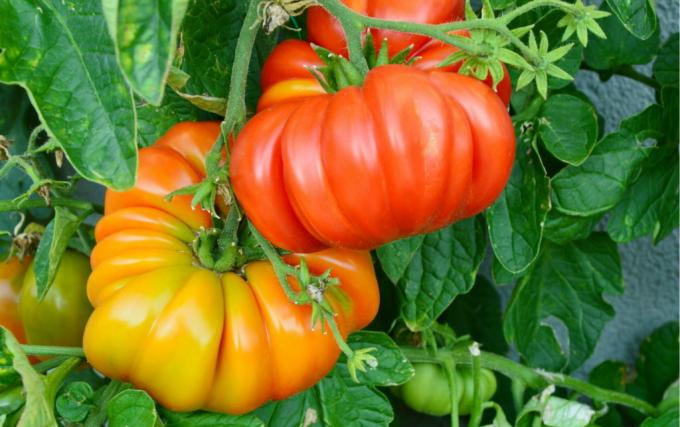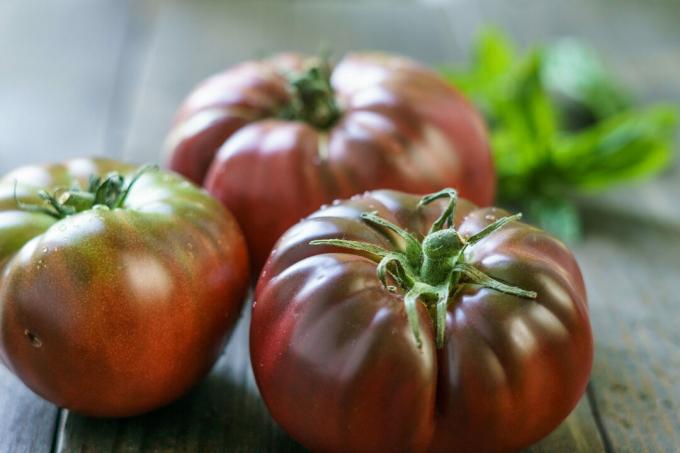The type of tomato ‘Brandywine’ impresses with its large, juicy fruits. You can find out everything you should know about growing the Brandywine tomato in our overview.

The large family of Brandywine tomatoes is sure to have something for every taste, because they are available in all imaginable colors and even as a cherry tomato variant. Here you will find the best types of ‘Brandywine’ as well as tips for the successful cultivation of the aromatic fruits.
contents
- Brandywine tomato: fact sheet
- Origin and history
- Brandywine tomato: the best varieties
- Characteristics and taste of the tomato brandywine
- Planting and caring for brandywine tomatoes: this is what you should pay attention to
- Harvest and use brandywine tomatoes
Brandywine tomato: fact sheet
| fruit | Beefsteak tomato; different colors |
| taste | fruity, sweet, spicy |
| Ripening time | medium early |
| growth | Stick tomato, up to 180 cm |
| Location | Greenhouse, protected open field |
Origin and history
The origin of the Brandywine is only vaguely handed down. It comes from the USA and came into the hands of the Seed Savers Exchange Association in 1982. An Ohio gardener named Ben Quisenberry had received it from Dorris Sudduth Hill. According to her, the beefsteak tomato Brandywine had been grown and passed down in her family for 80 years. It has not yet been clarified whether it was selected from a commercial variety or appears as a completely new variety. Since the 1980s, many color variants of the originally pink brandy wine have been created.
Brandywine tomato: the best varieties
The Brandywine family kept getting new members over the years. We present you the best varieties of this tasty tomato variant. The original color variant is now known as ‘Brandywine Pink’.
- ‘Brandywine Pink’ is the original form from the USA. At 700 grams, the fruits are real heavyweights. The leaves are potato-leaved, the tomatoes are dark pink outside and inside. Very fruity and aromatic aroma, when ripe the pulp has a soft, melting consistency.
- ‘Brandywine Red’ is a bright red beefsteak tomato with normal-leaved leaves and smaller fruits than the pink variant. The fruits, which weigh around 250 grams, ripen from August and impress with their fruity taste.
- ‘Brandywine Yellow’ is the sun yellow variant of this family. It also has potato-like leaves and forms fruits weighing up to 800 grams with a fruity-sweet taste and a lot of aroma.
- ‘Brandywine Apricot’ its color is reminiscent of a persimmon fruit. The beefsteak tomatoes, which weigh on average 400 grams, turn orange with a reddish tinge when ripe. The flesh is thick, juicy and melting, the taste aromatic and delicious.
- ‘Brandywine Purple’ arose from a cross between the ‘Brandywine’ and the variety "Marizol Purple" and came on the market in 1998. The color is dark pink to slightly purple. The plants are potato-leaved.
- ‘Brandywine Black’ is a potato-leaved, late-ripening, dark red to brownish beefsteak tomato. The fruits are slightly smaller and lighter than other ‘Brandywine’ varieties, on average they reach 350 grams. The taste is typical of dark tomatoes: spicy, sweet and fruity.
- ‘Brandywine Cherry’ is a relatively new variety from 1998, which supplements the beefsteak tomato series of the Brandywine with a pink, small-fruited, but also wonderfully aromatic variant.

Characteristics and taste of the tomato brandywine
In general, all brandywine tomatoes form large, ribbed and flat-round fruits and, with the exception of the ‘Brandywine Cherry’, are meat tomatoes. The foliage is often potato-leaved and the seeds germinate early. The plants reach about 160 to 180 centimeters in height. The aroma of the ‘Brandywine’ varieties is famous, their taste is uniquely delicious, often fruity and sweet, but also spicy. All Brandywine tomatoes are seed-proof and can be sown again from their own seeds next year.
Planting and caring for brandywine tomatoes: this is what you should pay attention to
Brandywine tomatoes are quite robust and not very susceptible to diseases. They grow particularly well in the greenhouse and outdoors. Outside they are happy to have a rain cover, as the soft skin of the large fruits easily bursts with uneven water supply. From the beginning of May the brandy wine can move into the greenhouse. However, you should only put the tomatoes outdoors after the ice saints. For planting, dig a deep hole and place your young plants in it. Then fill the hole with a nutrient-rich substrate, such as our Plantura Organic tomato and vegetable soil. It provides all the minerals and nutrients necessary for the growth and flowering of the brandywine to begin with. After planting, watering should be done properly.
The Brandywine should be grown with one, maximum two shoots. To do this, break out the side shoots early. Detailed instructions and further tips on the Skinning tomatoes we have put together for you in a separate article. Because of their heavy fruits, the Brandywine plants should always be well supported and tied up. From June we recommend organic fertilization to ensure the supply of nutrients for fruit formation. We recommend our Plantura for this Organic tomato fertilizer, which consists mainly of plant materials and has a long-term and even effect. The granulate is worked into the surface of the soil around the plants. Even watering supports the release of nutrients by the soil organisms.
Harvest and use brandywine tomatoes
Brandywine tomatoes are traditionally eaten freshly sliced on bread and burgers. Due to their great taste, they rarely make it from the garden to the kitchen and are best eaten fresh. The large beefsteak tomatoes are also very suitable for soups and sauces.
Do tomatoes always have to go into the greenhouse? What are the advantages and what should you look out for when buying a greenhouse? To the Growing tomatoes in greenhouses and plastic tunnels you can find out more here in our article.


